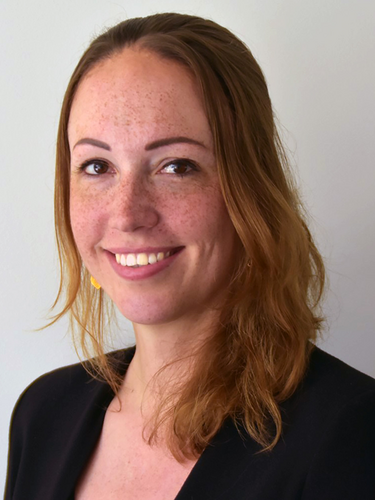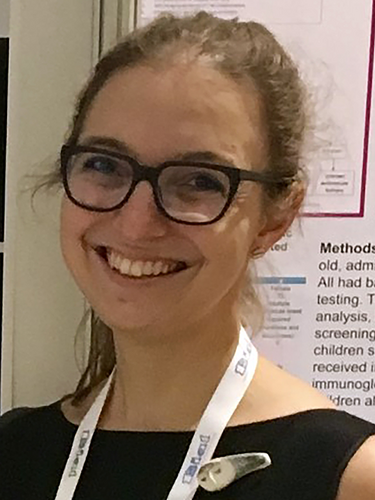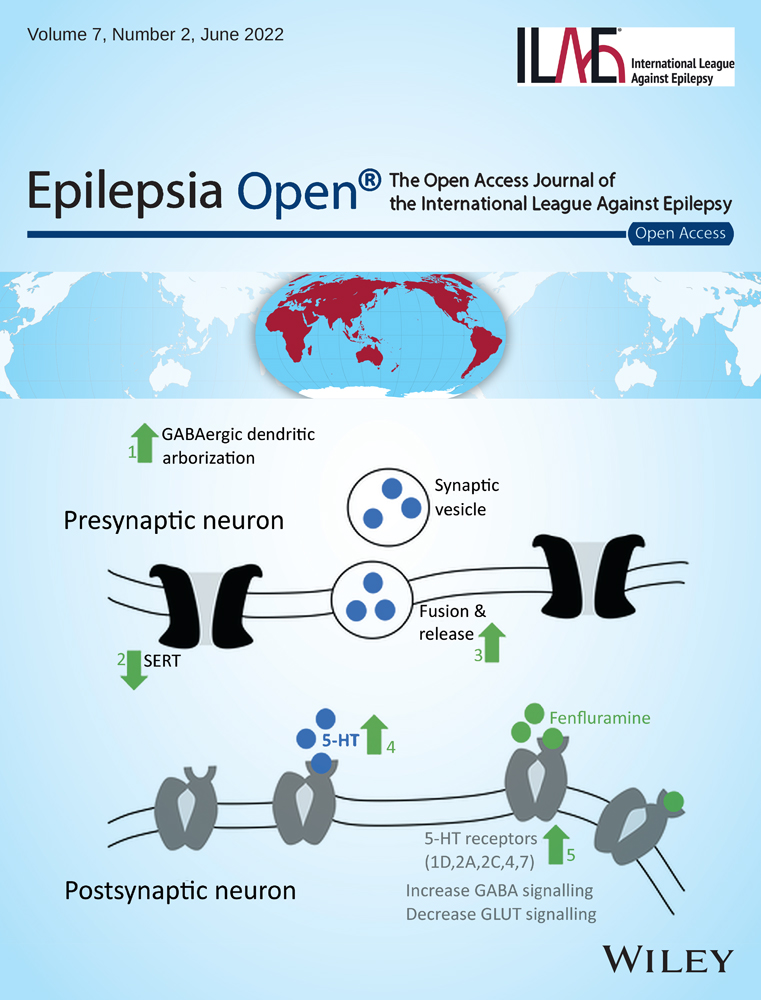An interview with Hanna Hulshof and Barbora Benova, 2022 Epilepsia Open Prize Winner for Clinical Research
1 Who are you?
Ever since medical school, it was my ambition to become a pediatric neurologist. I started my PhD in Tuberous Sclerosis Complex in 2014, aiming to identify neuroimaging biomarkers for epileptogenesis and neurodevelopment. In 2016, I started as a resident in neurology, and since then I have combined clinical work with research. I hope to finish my PhD at the end of this year, and my clinical training in 2024. In my personal time, I enjoy spending time with my family, friends, and—most of all—our daughter!
2 What got you interested in epilepsy research?
In medical school I wrote my thesis on first choice antiepileptic drugs per age at onset, epilepsy syndrome, and seizure type, and the results of this study were presented in a poster session at the 29th International Epilepsy Congress in Rome. Working on this project sparked my interest in epilepsy research. After medical school, I first gained experience in clinical work, and thereafter I conducted a randomized controlled trial into the efficacy of the modified Atkins diet for refractory epilepsy, to expand my research experience. When I was subsequently accepted as a PhD candidate and had the opportunity to take part in the promising FP7-funded EPISTOP project, I was very excited!
3 Explain for our general readership what question your study addressed and how did you go about designing you study?
Tuberous Sclerosis Complex (TSC) is an autosomal-dominant multisystem disorder with a high prevalence of epilepsy, with seizure onset occurring in 80% of patients before the age of two years. Early seizure control is important to decrease the risk of refractory epilepsy and neurodevelopmental delay. If drug treatment does not sufficiently control the seizures, epilepsy surgery should be considered. In TSC, localizing the epileptogenic zone can be challenging, due to the presence of multiple dysplastic lesions, multiple seizure types, and multifocal EEG abnormalities. With our study we aimed to identify features of the epileptogenic zone on structural MRI, distinguishing it from other TSC-associated changes. Furthermore, we aimed to design a tool for reproducible MRI assessment in TSC surgical candidates, in order to improve presurgical evaluation in TSC.
4 What were the results and how do you interpret your findings?
Our study shows that the epileptogenic zone in patients with TSC harbors a combination of multiple dysplastic features, and that certain features—calcification and the largest area affected with dysplastic features—carry more weight than others in assessing the epileptogenic zone. We found that no single abnormality at itself could be considered the hallmark of the epileptogenic zone, but that it is the combination and accumulation of these features in that area, compared to other brain areas. A detailed and reliable MRI assessment is therefore a crucial step in the presurgical evaluation of TSC patients. However, it is obviously always the combination of additional investigations that determines whether patients are suitable to continue with surgical resection.
5 What next steps in epilepsy research are you taking and what are your career goals?
Currently, I am combining my PhD with my clinical work as a resident in neurology. I hope to defend my thesis at the end of 2022, and then I will first focus on finishing my clinical training to become a pediatric neurologist. However, I aim to stay involved in TSC research while doing so. In the future, I would love to combine clinical work as a pediatric neurologist with epilepsy research.
6 What does the Epilepsia Open prize mean for you, your laboratory, research institute, and your future?
7 Who are you?
I am currently a research fellow at the Neurogenetics laboratory of the Department of Paediatric Neurology, Motol University Hospital in Prague, Czech Republic. I studied medicine at Charles University in Prague where I continued to pursue PhD in neuroscience. After two years in clinical practice, research in neurogenetics took a complete hold of my heart so I decided to dedicate my full interest to studying genetic causes of malformations of cortical development and epilepsy.
8 What got you interested in epilepsy research?
Ever since medical school, I have been curious about disease causes and how we can discover unknown disease etiologies. So going forward with PhD studies was a natural next step after graduation. At that time, the Department of Paediatric Neurology was just launching its participation in EPISTOP study focused on biomarkers and prevention of epileptogenesis in patients with tuberous sclerosis complex—and I was excited to get involved!
9 Explain for our general readership what question your study addressed and how did you go about designing you study?
In our study, we aimed to (i) describe in detail MRI features of the epileptogenic zone (EZ) in patients with tuberous sclerosis complex (TSC) and (ii) to provide a reproducible approach to evaluating MRI scans of epilepsy surgery candidates with TSC. We know that patients with TSC tend to have multiple dysplastic brain lesions and so we were curious whether we could find features that would "flag" the epileptogenic lesion among all of the remaining ones. Also, we know how challenging presurgical evaluation of MRIs of patients with TSC can be so we also aimed to design a tool for MRI evaluation of TSC that could help other neuroradiologists.
10 What were the results and how do you interpret your findings?
We found that the epileptogenic zone in TSC patients harbors multiple dysplastic features and the combination of specific features indicates the epileptogenic zone. EZ was identified by the combination of three of the following MRI features (tubers, transmantle sign, increased cortical thickness, calcifications, and the largest area affected with focal cortical dysplasia (FCD)), at least two of the following four MRI features (transmantle sign, increased cortical thickness, calcifications, largest FCD- affected area) or at least one of the two following features (calcifications, largest FCD- affected area). The main message of our study is that except for tubers, one needs to look for features traditionally associated with focal cortical dysplasia, and also for more "severe" changes in tubers themselves, like calcifications—the combination of these features can most reliably flag the "true" epileptogenic zone. What our study does NOT say is that one could proceed with surgical resection solely based on MRI—quite the contrary! However, a more reliable MRI evaluation leads to a more reliable hypothesis on the location and extent of the epileptogenic zone and, we believe, better patient outcomes.
11 What next steps in epilepsy research are you taking and what are your career goals?
Since I decided to switch from patient care more toward research and diagnostics, I have focused on elucidating genetic causes of malformations of cortical development—it is such an exciting field and I am so grateful that I can work here! And not being for my first steps in clinical research of TSC, I might have not even discovered it.
12 What does the Epilepsia Open prize mean for you, your laboratory, research institute, and your future?
First of all, it is an incredible honor! When Dr. Hulshof and myself found out we were nominated and later awarded the prize, we were genuinely overjoyed and fairly surprised—and after two long covid years, we cannot wait to meet in Geneva and celebrate completely off-line, in person, with a glass of prosecco somewhere out in the sun. Even more importantly, the prize reflects how much we cherish the collaboration of our two institutes, and also shows that the important findings happen when people meet, discuss, and collaborate.
Read the winning article “The epileptogenic zone in children with tuberous sclerosis complex is characterized by prominent features of focal cortical dysplasia”.






